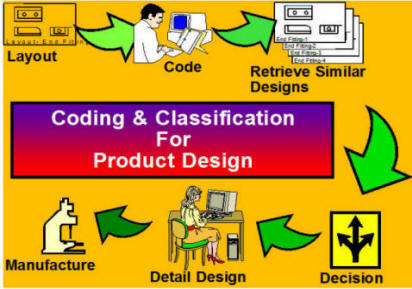Coding & Classification
For Complex Product/Process Mixes
Designing With C&C
With C&C, the designer defines the part configuration or requirements. A "Code Number" contains information about the part. This number might identify material, size, shape, function, process or other information.
The database of existing parts is then scanned to find items with identical or similar codes. He/she tries to find an existing part that will work or a part that can be modified to work. If neither approach is successful, the designer looks for current tooling that will work with a new part.
This avoids detail design for many parts and avoids many tooling costs.
Existing parts have a cost history that helps product costing. Where a new part is required, designers learn from examining current drawings, tooling and cost history. They then incorporate this knowledge in the new design. Group Technology thus institutionalizes organizational learning.

Coding &Classification in Manufacturing
Coding systems for manufacturing usually have both product and process information. The analyst works with both.
If there is a great deal of inconsistency in existing processes, the analyst can revert to the more fundamental characteristics such as size, shape and material.
Parts with similar physical characteristics should usually have similar processes. The coding system allows an analyst to standardize process routings and then group the parts into families.
The example below shows a small part of a database for castings. Each digit position represents a particular part characteristic. For examples the third position indicates the casting's finished weight.
Each character in the code carries information about the product characteristic assigned to that digit position. For example, a "1" the third character position might indicate a finished weight between 1.0 and 5.0 pounds.
Through sorting, retrieval and specialized algorithms, the analyst groups similar parts as shown.
Implementing Coding & Classification
Coding and Classification presents some major challenges that are not usually evident to an inexperienced practitioner. This is especially true of large databases. But, then, large projects, have correspondingly large returns.
A successful project requires experience and judgment in coding system design, initial coding and in family development. It is not a task for the novice.
■ ■ ■ ■ ■ ■ ■




